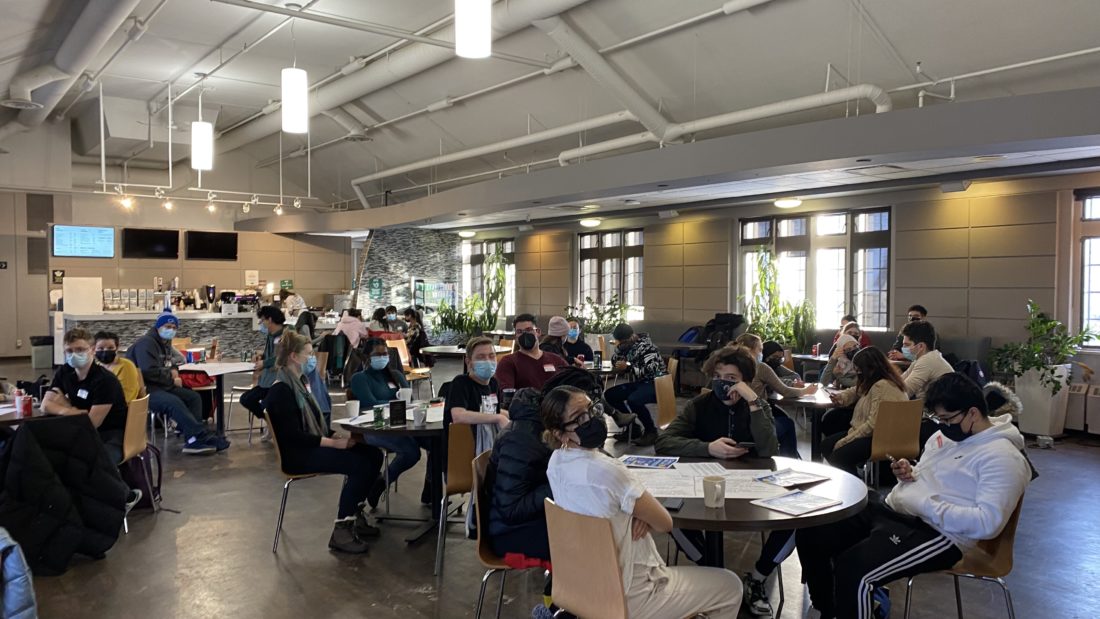
On March 2, campus groups at the University of Saskatchewan gathered at Louis’ Loft for a Campus Leadership Summit.
Organized by the U of S Students’ Union, roughly 40 student attendees attended the supper and participated in games and conversations aimed at helping new campus groups get acquainted with larger, more established groups.
Abhineet Goswami, USSU vice president of operations and finance, organized the summit. Goswami says that it can be difficult for new groups to get past the initial phase of growth.
“If there are only ten members in a group, you cannot promote your group. You cannot bring creativity. You cannot engage other people. You’re only stuck with ten people in a year,” Goswami said.
All undergraduate students are able to initiate campus groups at the University of Saskatchewan, but growing them presents another challenge.
There are currently over 150 campus groups at the U of S, nearly 100 of which are ratified, meaning that they are officially endorsed by the USSU and eligible for various funding and support. Whether by tabling in the arts tunnel or posting on social media, each group strives to bring in new members to expand the range of activities they can accomplish.
The Leadership Summit comes as a part of a series of efforts by the USSU to help campus groups establish themselves this academic year. These included the launch of the USSU Hub, a website for campus groups to easily access policies and apply for resources, and the first-ever Campus Groups Handbook, compiled by Goswami based on common questions from new groups.
Now, a new strategy that the USSU is employing to support new campus groups is to help students help one other.
“The major thing I think the university’s lacking is engagement between students. So from here, they can follow each other on Instagram, they can exchange their contact. I think that’s why it’s built more and more interclub relations,” Goswami said.
Halda Wang, a second-year biology student, attended the summit as a member of the Arts and Science Students’ Union and USask Improv.
“I think this is a good opportunity for members of different clubs throughout the campus to come together and get to know what other clubs do and kind of have that communication,” Wang said.
Goswami says he has encouraged campus groups to uplift each other since the last campus group gathering in September.
“I’m seeing it in my grants too, actually. Even in a COVID year, I received so many grants. And in one week, I have received 12 grants in total and I can see when collaboration [occurs] between a lot of groups. So it’s really helping,” Goswami said.
Ratified campus groups can receive $1,000 per academic year through the Project and Initiatives Grant to carry out their activities, and may apply for other grants offered by the USSU as well. The USSU distributes more than $50,000 in additional grants, which include the Anti-Racism & Anti-Oppression Grant and the Sustainability Grant.
Goswami says that while larger campus groups that are better established tend to have more funding available and less interest in events like the Leadership Summit, they also enable student leaders to meet and discuss the burdens of running a campus group.
“[Student leaders can discuss] what they are going through. Student engagement issues, no one is coming to their events, they’re having financial crises, they’re having government issues… They can really relate and talk.”
In previous years, similar gatherings of campus groups relied on presentations to convey information, but Goswami feels that enabling discussion between the groups themselves improves the experience.
“I think this is the most effective way of interaction. It really helps people to grow.”
—
Sandra LeBlanc
Photo: Supplied by Abhineet Goswami